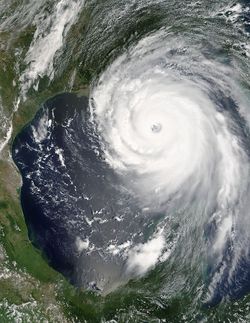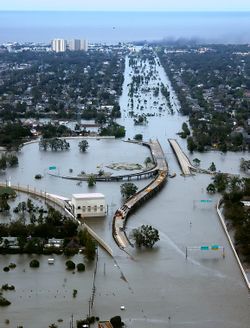Hurricane

Hurricanes are large storms (see figure 1) with winds of 119 km/hr or higher.[2] The generic, scientific term for these storms, regardless of where they occur, is tropical cyclone. They form near the equator over warm ocean waters. The term hurricane is used only for the large storms that form over the Atlantic Ocean or the eastern Pacific Ocean. When a hurricane reaches land, it pushes a wall of ocean water towards the land. This wall of water that forms is called a storm surge, and when mixed in with heavy rain, it can cause flooding, especially near the coast.

A hurricane starts out as a tropical disturbance, an area over warm ocean waters where rain clouds are forming. Tropical cyclones are like engines that require warm and moist air as the fuel. So the first ingredient needed for a tropical cyclone is warm ocean water. That is why tropical cyclones form only in tropical regions where the ocean is at least 26°C for at least the top 50 meters below the surface.[4] The second ingredient for a tropical cyclone is wind. Hurricanes that form in the Atlantic Ocean, the wind blowing westward across the Atlantic from Africa provides the necessary ingredient. As the wind passes over the ocean's surface, water evaporates and turns into water vapour and rises. As it rises, the water vapour cools, and condenses back into large water droplets, forming large cumulonimbus clouds.[4]
Categorizing Hurricanes
Hurricanes are categorized by wind speeds using the Saffir-Simpson Hurricane Scale. The Saffir-Simpson Hurricane Wind Scale is a 1-5 scale that categorizes hurricanes based on their intensity at a specific time. Damages typically rise by a factor of four for every category increase.[5] The scale does not address the potential for such other hurricane related impacts such as waves, storm surge, floods, or tornadoes.
- Category 1: Winds 119-153 km/hr[2]
- Category 2: Winds 154-177 km/hr[2]
- Category 3: Winds 178-208 km/hr[2]
- Category 4: Winds 209-251 km/hr[2]
- Category 5: Winds more than 252 km/hr[2]
Hurricane Strength and Climate Change:
The frequency of hurricanes generally decreases in the Atlantic and Western pacific regions during El Niño. While these areas experience a decrease, the central North and South Pacific regions experience an increase in hurricanes.[6]
By the end of the century, tropical storms are predicted to become 2-11% more intense due to anthropogenic warming.[7] This increase would lead to more economic and social damage. It would also lead to higher rainfall rates compared to present day, with models predicting an increase of 10-15%.[7] Hurricane models also project that the maximum intensity of hurricanes bred in the Atlantic will increase by about 5% by the year 2100.[7]
The video below is a lecture from Prof. David Archer, Department of Geophysical Sciences at the University of Chicago,[8] talking about hurricanes and how climate change effects hurricanes:
References
- ↑ By Jeff Schmaltz, MODIS Rapid Response Team, NASA/GSFC - http://visibleearth.nasa.gov/view_rec.php?id=7938, Public Domain, https://en.wikipedia.org/wiki/Hurricane_Katrina#/media/File:Hurricane_Katrina_August_28_2005_NASA.jpg
- ↑ 2.0 2.1 2.2 2.3 2.4 2.5 "What Are Hurricanes?", NASA, 2016. [Online]. Available: http://www.nasa.gov/audience/forstudents/5-8/features/nasa-knows/what-are-hurricanes-58.html. [Accessed: 12- Jun- 2016].
- ↑ AP Photo/U.S. Coast Guard, Petty Officer 2nd Class Kyle Niemi, Public Domain, https://en.wikipedia.org/wiki/Hurricane_Katrina#/media/File:KatrinaNewOrleansFlooded_edit2.jpg
- ↑ 4.0 4.1 "NOAA': How does a hurricane form?", NASA, 2016. [Online]. Available: http://scijinks.jpl.nasa.gov/hurricane/. [Accessed: 08- Jun- 2016].
- ↑ "Saffir-Simpson Hurricane Wind Scale.", NOAA, 2016. [Online]. Available: http://www.prh.noaa.gov/cphc/pages/aboutsshs.php. [Accessed: 14- Jun- 2016].
- ↑ "Evidence for Changes in Tropical Storms - AR4 WGI Chapter 3: Observations: Surface and Atmospheric Climate Change", Ipcc.ch, 2016. [Online]. Available: https://www.ipcc.ch/publications_and_data/ar4/wg1/en/ch3s3-8-3.html. [Accessed: 10- Jun- 2016].
- ↑ 7.0 7.1 7.2 "Geophysical Fluid Dynamics Laboratory - Global Warming and Hurricanes", NOAA, 2016. [Online]. Available: http://www.gfdl.noaa.gov/global-warming-and-hurricanes. [Accessed: August 3, 2016].
- ↑ Prof. David Archer has graciously allowed the use of this and other videos in a private communication with Jason Donev.

